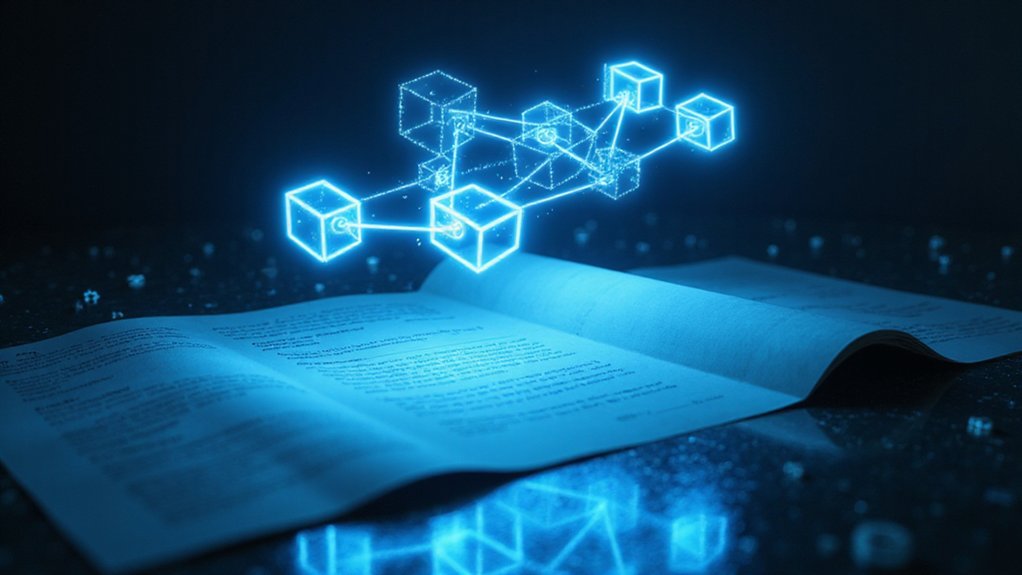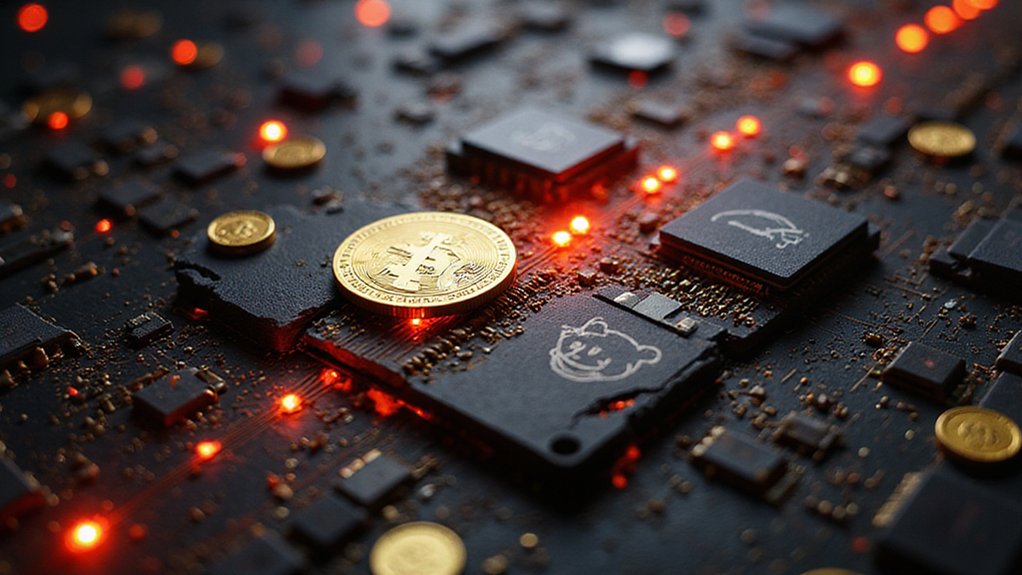Smart contracts are self-executing digital agreements that operate on blockchain networks, eliminating intermediaries while establishing a trustless environment where code—not human judgment—arbitrates transactions. Conceptualized by Nick Szabo in 1994 but only realized with blockchain technology, these automated programs trigger when predetermined conditions are met, creating immutable records validated by network consensus. Written primarily in languages like Solidity, they offer automation, security, and transparency, despite facing hurdles in scalability and legal integration. The financial revolution they promise remains tantalizingly within reach.

Blockchain technology catapults us into a future where transactions unfold without the cloak of intermediaries, and at the heart of this revolution lie smart contracts—those self-executing digital agreements that have fundamentally altered how parties conduct business in an increasingly decentralized world.
These algorithmic marvels exist as programs that automatically execute when predetermined conditions are met, effectively eliminating the need for trusted third parties in transactions between mutually suspicious counterparties.
The genius, one might observe, lies not merely in the automation but in the creation of a trustless environment where code—not corruptible human judgment—serves as arbiter.
Smart contracts operate within the secure confines of blockchain technology, where data resides not in vulnerable centralized repositories but across distributed networks of computers.
This decentralized architecture creates an immutable ledger where transactions, once recorded in blocks through consensus mechanisms, remain permanently etched—a feature that renders the system remarkably resistant to manipulation. The validation process relies on blockchain nodes that independently verify each transaction according to the network’s established rules, ensuring integrity across the entire system. Originally conceptualized by cryptographer Nick Szabo in 1994, smart contracts were envisioned as a way to formalize and secure relationships on public networks.
The cryptographic algorithms underpinning these systems guarantee that, despite the absence of centralized authority, security and integrity remain paramount.
The anatomy of a smart contract reveals a sophisticated organism comprising state variables that store data, functions that execute specific actions, events that facilitate communication, and modifiers that implement access controls. Smart contracts written in Solidity language provide a structured approach for implementing logic on blockchain platforms like Ethereum, where they can interact with other contracts and maintain persistent state.
When triggered by a transaction, these contracts execute deterministically across multiple nodes, producing identical outcomes regardless of which node processes them (a far cry from the subjective interpretations plaguing traditional contractual arrangements).
Benefits abound: automation drives efficiency by reducing transaction times and costs; blockchain’s inherent security features protect agreements; transparency grants all parties visibility into execution processes; and immutability ensures indelible record-keeping.
Yet limitations persist—technical complexity demands specialized expertise; scalability challenges continue to hamper widespread adoption; and existing legal frameworks struggle to accommodate these digital innovations.
Despite these obstacles, smart contracts represent an extraordinary convergence of technology and commerce, offering glimpses into a future where trust is programmatically encoded rather than socially constructed.
Frequently Asked Questions
How Do Smart Contracts Handle Disputes Between Parties?
Smart contracts incorporate dispute resolution mechanisms through built-in protocols, leveraging blockchain’s infrastructure to facilitate fair conflict resolution.
Platforms employ Online Dispute Resolution (ODR), decentralized arbitration systems like Kleros, and expert juror selection to adjudicate contentious matters.
The immutable nature of blockchain provides transparency, while coded provisions can specify resolution pathways before disputes arise.
Despite these innovations, challenges persist—legal recognition varies by jurisdiction, and the technical complexity occasionally bewilders non-experts (who could have predicted blockchain would require its own jurisprudence?).
What Skills Are Needed to Develop Smart Contracts?
Developing smart contracts demands a multifaceted skill arsenal that transcends mere coding ability.
Competent developers must possess proficiency in Solidity (Ethereum’s lingua franca), while maintaining robust security awareness—a single misplaced semicolon can, rather inconveniently, lead to million-dollar exploits.
Beyond technical prowess, one needs blockchain fundamentals, expertise with development frameworks like Hardhat, and soft skills including meticulous attention to detail.
The field’s rapid evolution further necessitates adaptability—yesterday’s best practices become tomorrow’s vulnerabilities with remarkable consistency.
Can Smart Contracts Be Updated After Deployment?
Smart contracts can indeed be updated after deployment, contrary to blockchain’s immutability ethos, through upgradeability patterns.
The dominant approach—the proxy pattern—separates logic from storage, allowing developers to deploy new implementation contracts while preserving state and user interfaces.
This architectural sleight-of-hand enables bug fixes and feature enhancements without disrupting users.
However, this flexibility introduces complexity and potential attack vectors; the permission to upgrade represents a centralization risk that requires meticulous governance controls.
What Are the Environmental Impacts of Smart Contract Platforms?
Smart contract platforms exhibit decidedly mixed environmental credentials.
Their primary impact stems from energy consumption—particularly pronounced in proof-of-work blockchains, which devour electricity with remarkable voracity.
Hardware obsolescence drives e-waste generation, while resource extraction for mining equipment depletes finite materials.
Yet, ironically, these same platforms enable promising environmental solutions: carbon tracking mechanisms, offset markets with enhanced transparency, and peer-to-peer energy trading networks.
The technology’s environmental ledger, much like its distributed one, contains both debits and credits.
How Do Smart Contracts Interact With Traditional Legal Frameworks?
Smart contracts occupy a curious legal limbo—simultaneously disrupting and adapting to traditional frameworks.
These blockchain-based agreements challenge conventional notions of jurisdiction, enforceability, and contract formation while promising efficiency gains that courts and legislators can hardly ignore.
The integration requires legal professionals to embrace technical literacy (a somewhat optimistic expectation) and jurisdictions to develop standardization mechanisms.
As regulatory frameworks evolve, smart contracts increasingly incorporate compliance mechanisms, though the patchwork of international legal approaches continues to complicate cross-border transactions.









